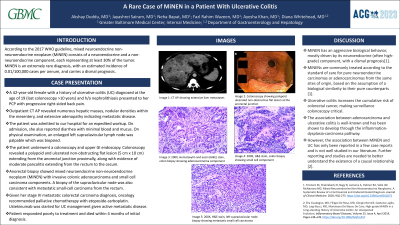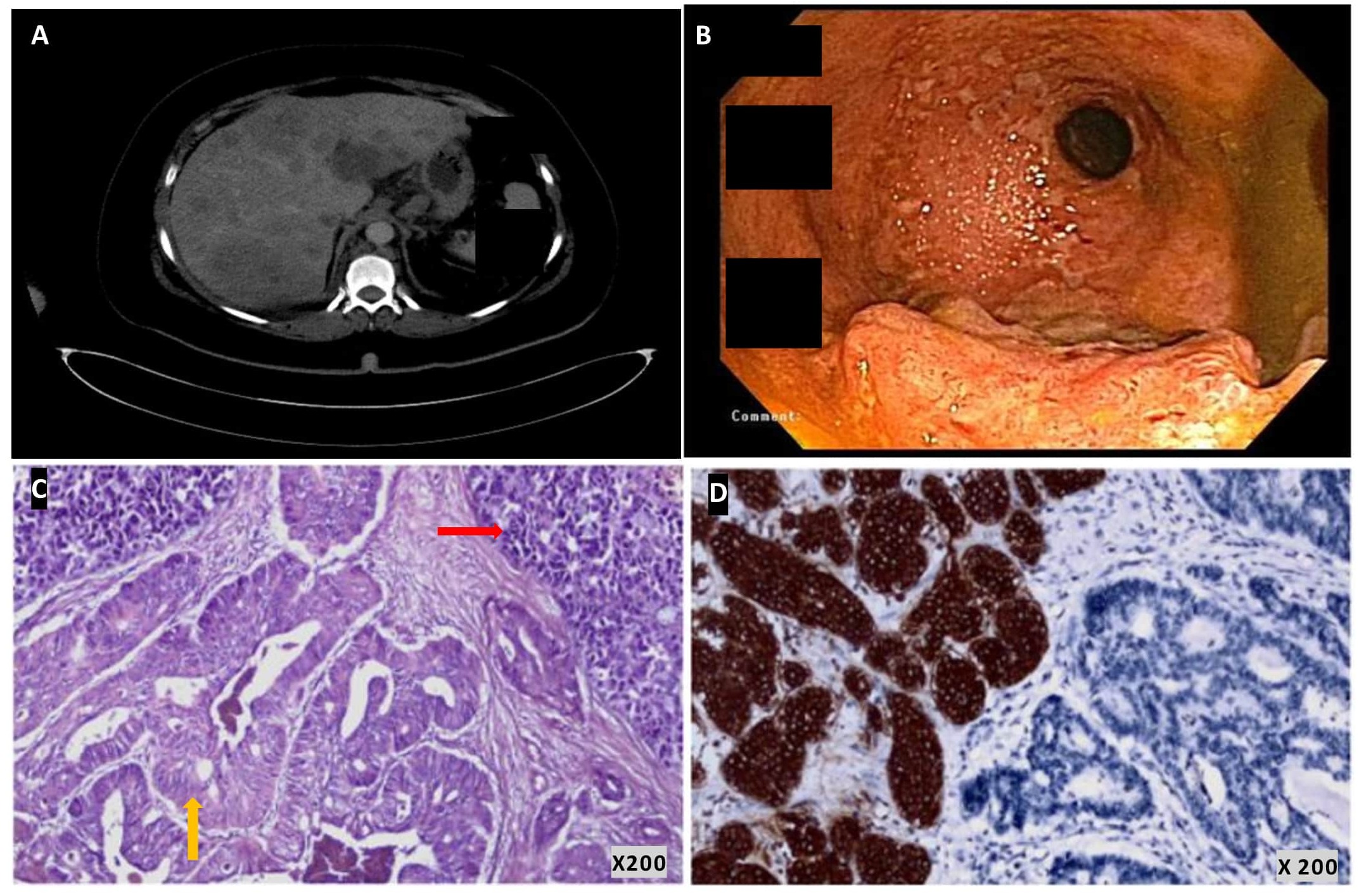Tuesday Poster Session
Category: Colorectal Cancer Prevention
P3214 - A Rare Case of MiNEN in a Patient With Ulcerative Colitis
Tuesday, October 24, 2023
10:30 AM - 4:00 PM PT
Location: Exhibit Hall

Has Audio
- AD
Akshay Duddu, MD
Greater Baltimore Medical Center
Towson, MD
Presenting Author(s)
Akshay Duddu, MD, Jayashrei Sairam, MD, Neha Bapat, MD, Fazl Rahim Wazeen, MD, Ayesha Khan, MD, Diana Whitehead, MD
Greater Baltimore Medical Center, Towson, MD
Introduction: According to the 2017 WHO guidelines, mixed neuroendocrine non-neuroendocrine neoplasm (MiNEN) consists of a neuroendocrine and a non-neuroendocrine component, each representing at least 30% of the tumor. In addition, MiNEN is an extremely rare diagnosis, with an estimated incidence of 0.01/100,000 cases per annum with invasive colonic adenocarcinoma reported as the primary site of origin in 14% of cases. We present a case of MiNEN with components of invasive colonic adenocarcinoma and metastatic small-cell carcinoma in a young woman who has a longstanding history of untreated ulcerative colitis (UC).
Case Description/Methods: A 42 year old woman with a history of UC diagnosed at the age of 19 and nephrolithiasis presented to her primary care physician with progressive right-sided back pain for two weeks. Given her history of nephrolithiasis, an outpatient CT abdomen and pelvis was obtained. The CT revealed multiple hepatic masses, nodular densities within the mesentery, and extensive adenopathy indicating metastatic disease with an unknown primary. Patient was admitted to the medical floor for an expedited workup. On physical examination, an enlarged left supraclavicular lymph node was palpable. The patient underwent a colonoscopy and upper GI endoscopy. Colonoscopy revealed an ulcerated non-obstructing flat lesion (5 cm x 10 cm) extending from the anorectal junction proximally. Additionally, moderate pancolitis was observed, extending from the rectum to the cecum. Biopsy results revealed MiNEN with components of invasive colonic adenocarcinoma and small-cell carcinoma. A biopsy of the supraclavicular node also confirmed metastatic small-cell carcinoma originating from a colonic primary. Immunohistochemical staining showed no loss of expression for MLH1, MSH2, MSH6, and PMS2, making microsatellite instability-associated tumors and Lynch syndrome unlikely. She was diagnosed with stage IV metastatic cancer, and palliative chemotherapy was initiated.
Discussion: Ulcerative colitis increases the cumulative risk of colorectal cancer, hence surveillance colonoscopy is essential. The association between adenocarcinoma and UC is well-known and has been shown to develop through the inflammation-dysplasia-carcinoma pathway. The association between MiNEN and IBD has been reported in only a few case reports and is not well studied in our literature. Therefore, our case adds to the growing evidence. Further reporting and studies are needed to better understand the existence of a causal relationship.

Disclosures:
Akshay Duddu, MD, Jayashrei Sairam, MD, Neha Bapat, MD, Fazl Rahim Wazeen, MD, Ayesha Khan, MD, Diana Whitehead, MD. P3214 - A Rare Case of MiNEN in a Patient With Ulcerative Colitis, ACG 2023 Annual Scientific Meeting Abstracts. Vancouver, BC, Canada: American College of Gastroenterology.
Greater Baltimore Medical Center, Towson, MD
Introduction: According to the 2017 WHO guidelines, mixed neuroendocrine non-neuroendocrine neoplasm (MiNEN) consists of a neuroendocrine and a non-neuroendocrine component, each representing at least 30% of the tumor. In addition, MiNEN is an extremely rare diagnosis, with an estimated incidence of 0.01/100,000 cases per annum with invasive colonic adenocarcinoma reported as the primary site of origin in 14% of cases. We present a case of MiNEN with components of invasive colonic adenocarcinoma and metastatic small-cell carcinoma in a young woman who has a longstanding history of untreated ulcerative colitis (UC).
Case Description/Methods: A 42 year old woman with a history of UC diagnosed at the age of 19 and nephrolithiasis presented to her primary care physician with progressive right-sided back pain for two weeks. Given her history of nephrolithiasis, an outpatient CT abdomen and pelvis was obtained. The CT revealed multiple hepatic masses, nodular densities within the mesentery, and extensive adenopathy indicating metastatic disease with an unknown primary. Patient was admitted to the medical floor for an expedited workup. On physical examination, an enlarged left supraclavicular lymph node was palpable. The patient underwent a colonoscopy and upper GI endoscopy. Colonoscopy revealed an ulcerated non-obstructing flat lesion (5 cm x 10 cm) extending from the anorectal junction proximally. Additionally, moderate pancolitis was observed, extending from the rectum to the cecum. Biopsy results revealed MiNEN with components of invasive colonic adenocarcinoma and small-cell carcinoma. A biopsy of the supraclavicular node also confirmed metastatic small-cell carcinoma originating from a colonic primary. Immunohistochemical staining showed no loss of expression for MLH1, MSH2, MSH6, and PMS2, making microsatellite instability-associated tumors and Lynch syndrome unlikely. She was diagnosed with stage IV metastatic cancer, and palliative chemotherapy was initiated.
Discussion: Ulcerative colitis increases the cumulative risk of colorectal cancer, hence surveillance colonoscopy is essential. The association between adenocarcinoma and UC is well-known and has been shown to develop through the inflammation-dysplasia-carcinoma pathway. The association between MiNEN and IBD has been reported in only a few case reports and is not well studied in our literature. Therefore, our case adds to the growing evidence. Further reporting and studies are needed to better understand the existence of a causal relationship.

Figure: Image A: Computed tomography showing multiple heterogenous liver metastases; Image B: Colonoscopy showing anorectal mass; Image C: Histopathology showing both adenocarcinoma (Yellow arrow) and small cell carcinoma (Red arrow) components 200x; Image D: Histopathology showing immunostaining with synaptophysin in the neuroendocrine component, x200
Disclosures:
Akshay Duddu indicated no relevant financial relationships.
Jayashrei Sairam indicated no relevant financial relationships.
Neha Bapat indicated no relevant financial relationships.
Fazl Rahim Wazeen indicated no relevant financial relationships.
Ayesha Khan indicated no relevant financial relationships.
Diana Whitehead indicated no relevant financial relationships.
Akshay Duddu, MD, Jayashrei Sairam, MD, Neha Bapat, MD, Fazl Rahim Wazeen, MD, Ayesha Khan, MD, Diana Whitehead, MD. P3214 - A Rare Case of MiNEN in a Patient With Ulcerative Colitis, ACG 2023 Annual Scientific Meeting Abstracts. Vancouver, BC, Canada: American College of Gastroenterology.
